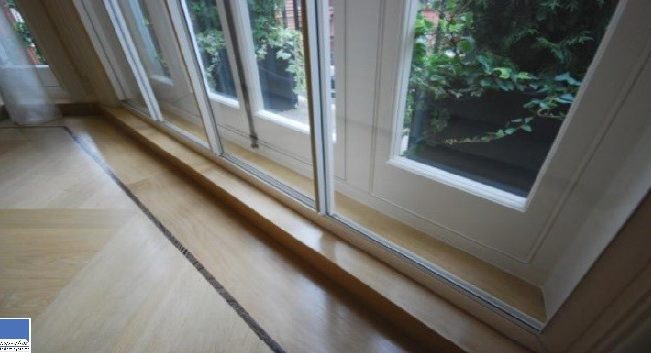Secondary glazing in Oxfordshire
Specialist suppliers and fitters of bespoke secondary glazing solutions
Secondary glazing cuts heat loss and reduces noise, making your home, office or other building a more comfortable place to be. It’s cost-efficient, can reduce your energy bills, and is installed without touching your existing windows or changing the character of your building.
As Oxfordshire and Buckinghamshire’s local window experts, Silent View Windows can supply and install the perfect secondary glazing solutions for your home or commercial property. We’ll help you every step of the way, from measuring up to installation and aftercare, to make sure your secondary-glazed windows are energy efficient and looking fantastic.
What is secondary glazing?
Secondary glazing is a lightweight aluminium window fitted inside of your existing window. It provides an alternative to ripping out old windows and replacing them with modern double-glazed versions.
Secondary glazing is designed so that its bars and sightlines exactly match those of the window it is fitted to. This means that you can’t see it from outside of the property – and it’s also discreet from the inside.
It has opening sections that match those on the original windows, so it doesn’t get in the way when you want to open your windows. Fitting secondary glazing to your existing windows provides many benefits, including conservation and cost.
Where to use secondary glazing?
Secondary glazing is versatile by nature, meaning it can be used on practically any window in any building from Abingdon and Faringdon to Bletchley and Buckingham. It’s the ideal way to improve the efficiency of your building’s windows, even if they’re already double-glazed. By adding a secondary panel on the internal recess, it can provide even more thermal efficiency and noise reduction.
That said, secondary double glazing is also a prime candidate for period buildings with original windows. If your building is listed or located in a conservation area, it’s likely that window replacement isn’t an option – either because it will damage the building’s character, or even because it’s actually prohibited.
Yet many original windows have an inherent problem. If they are more than 30 years old, it’s likely that they are single-glazed. Single-glazed windows are cold, draughty and terrible at stopping heat from inside the building escaping. And with today’s rising energy costs, that makes them expensive too.
Secondary glazing solves this problem by adding a second, unobtrusive window inside the original. This creates a double-glazed effect without having to alter the existing windows in any way.
The benefits of secondary glazing
With so many companies out there – ourselves included – offering effective double- and even triple-glazed windows, many property owners ask why they should opt for secondary glazing? Above all else, it comes down to what’s best for you and your property.
Secondary glazing offers a range of benefits over both single-glazed windows and double-glazed replacements.
Cost-effective
It is usually much cheaper to fit secondary glazing than it is to replace your original windows with modern ones. Secondary double glazing is simpler to manufacture and easier to fit than modern double-glazing. It uses far fewer raw materials, and you don’t have to touch the existing windows to install it.
As well as reducing the cost of the secondary glazing unit, that minimises the cost of labour. Add all that together, and secondary glazing provides a far more cost-effective solution than window replacement.
Noise reduction
Many properties in the UK suffer from noise pollution in various forms. This can be traffic noise, trains, planes or airports, or simply the general noise levels that you get in towns and cities. The result is an uncomfortable home where you can’t relax and even sleep, or an office where concentration levels are constantly disrupted.
Fortunately, secondary double glazing is an excellent way of reducing noise and sound pollution. Standard secondary glazing fitted over an existing single glazed window could reduce noise by up to 70%. Using laminated or acoustic glass instead of 4mm float glass increases the sound insulation even more.
What many people don’t realise, however, is that secondary glazing is usually the best option available, as it even outperforms modern double glazing at blocking noise. This is because – when it comes to windows – the most significant factor for reducing noise is the gap between panes of glass.
Double-glazing relies on sealed glass units, where the two pieces of glass are typically 24mm or 28mm apart. With secondary glazing the two pieces of glass are more likely to be around 100mm or more apart. That larger gap is far more effective at dissipating sound waves as they travel into your building.
The other factor that influences acoustic performance is the glass used. Standard 4mm glass used in secondary glazing will typically give a noise reduction of round 40 decibels (dB). Using different glass can increase this reduction, with the following approximate values:
- 6mm float glass (43dB)
- 4mm laminated glass (46dB)
- 8mm acoustic laminated (50dB)
Thermal efficiency
Windows are a key area for heat loss in any building, and single glazed windows are particularly poor at preventing heat loss. Even double-glazed windows can fail to keep heat in your home or commercial property, with small gaps in the seal allowing air to pass through.
Whatever the case, installing secondary glazing can dramatically improve the thermal efficiency of your windows. Even with standard 4mm glass it can halve the amount of heat lost through your single-glazed windows by improving the U-value from around 4 W/m2K to 2 W/m2K or better.
Adding thermally efficient low-e glass (such as Pilkington K) improves things even more, bringing the U-value down to around 1.5. The result is a more comfortable living or working space, without the need to constantly crank up the heating.
Condensation
Anyone with single-glazed windows will understand the frustration and hassle of condensation. It occurs when moisture from the warm air is drawn to the cold surface of your windows. Naturally, all homes have moisture from cooking, showering and even breathing.
However, those with single-glazed windows are particularly prone to it. The single panel of glass becomes seriously cold in the autumn and winter months, with nothing separating it from the outside weather. That cold interior surface essentially acts as a magnet for moisture, with condensation on your windows on a daily basis.
While constant ventilation could reduce the issue, it’s hardly practical when you want to keep your home warm. That’s where secondary glazing can help. The secondary panel completely seals off your existing windows, so the moisture from the air inside your building can’t get to them. It also stops the internal surface getting as cold, with the windows now acting more like double glazing.
That means no more misty windows, no need to constantly wipe them down and no more pools of water gathering on the windowsill.
Convenience
If your property is subject to any specific regulations, if it’s a listed building for example, you may need approval before fitting secondary glazing. However, secondary glazing is not a replacement window, which means that it is not subject to UK building regulations. In turn, this means that there is no time-consuming, expensive building control approval process – or far less in the case of listed properties.
On top of that, ripping out old windows is time-consuming, messy and often disruptive. Secondary glazing can be installed in much less time, with no need to make your home or office unusable for hours or days.
Security
Doors are naturally the first port of call for burglars. Next stop? The windows. While a locked door is pretty tricky to navigate, weak single- or even double-glazed windows are a different story. A quick smash can leave your property completely accessible, leaving you out of pocket, not to mention the emotional stress.
Secondary glazing can provide a robust additional barrier that significantly improves security. It’s very difficult to open secondary glazing from the outside. So even if an intruder gets past the main window, the secondary adds another layer that would take time to get through.
There’s also the option of difficult-to-break safety glass (such as toughened or laminated), which can make secondary glazing even more secure for your home or office. In most cases, it’s often enough to put opportunist intruders off altogether. If they do chance their arm, it will take them much longer, vastly reducing the chance of them getting in and out unnoticed.
Shake, rattle (and roll?)
Secondary glazing is renowned for the way it reduces noise coming through your windows. It can also reduce the noise from the windows themselves. Old timber windows, particularly sash windows, are almost synonymous with shakes and rattles. They’re draughty, noisy, and allow dust and dirt through. Secondary glazing provides an effective barrier, making the environment inside that much more pleasant.
Environmentally sound
Whether it’s a townhouse in Bicester, an office in Milton Keynes or a listed building in Aylesbury, installing secondary glazing usually provides a more environmentally friendly choice, for three reasons:
- The improved thermal efficiency mentioned above reduces heat loss. That means you don’t need to crank up the heating as much, minimising your energy consumption in the long run.
- Aluminium uses less fossil fuels in its production than the uPVC used in most modern replacement windows. Also, there is less material in a secondary window than there is in a replacement window.
- Repair and reuse! Why condemn your old windows to the landfill site when you can extend their life by installing secondary glazing? And if you ever remove your secondary glazing, aluminium is easy to recycle and in high demand.
Secondary glazing from local experts
The benefits of secondary glazing are clear. At Silent View Windows, we can help you reap those rewards with the best products supplied and professionally installed throughout Oxfordshire and the surrounding areas. Based in Thame, we can provide local consultation, site visits and assistance with the design and planning process to make sure you get the right secondary glazing for your requirements.
Our specialist team can offer expert installation to ensure your secondary glazing has the maximum effect on heat retention, sound insulation and condensation reduction, with the minimum impact on style. Want to find out more? Get a free, no obligation quote from our team on 01844 397 700.


